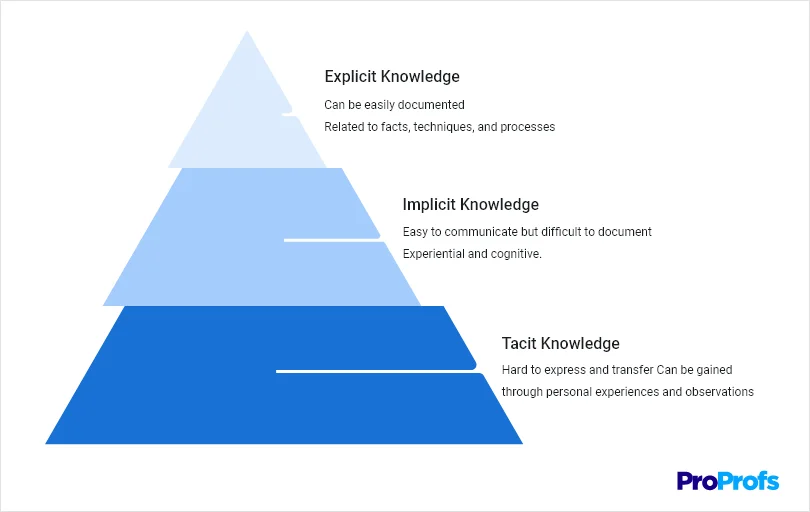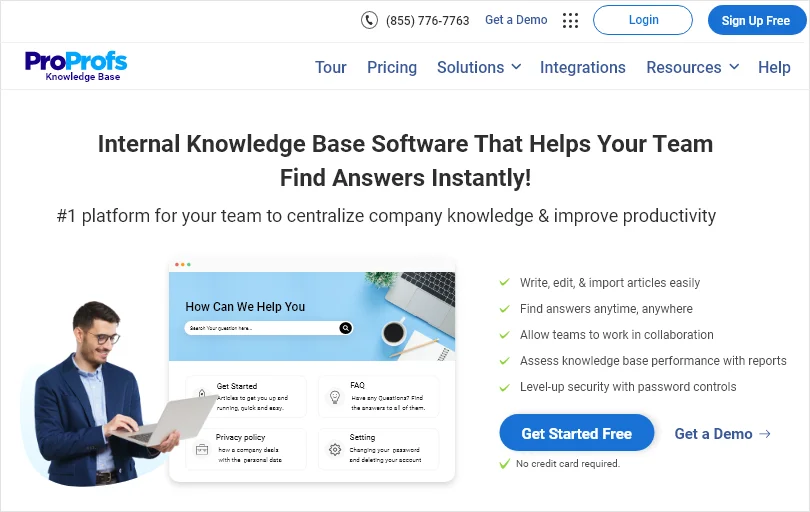In the bustling business world, where every company is striving to succeed, there is a silent superpower at play—an invisible force that holds the potential to propel businesses to extraordinary heights.
It’s called tacit knowledge. A hidden treasure that often goes unnoticed, yet its impact can be profound and far-reaching.
Tacit knowledge is the wisdom employees gain through personal experiences, insights, and intuition. It resides within your organization, concealed in the minds of your employees—the frontline salesperson who effortlessly builds rapport with customers and the project manager who navigates complexities with ease.
In this blog, we embark on an exploration of tacit knowledge—a journey that will uncover its significance, benefits, and best practices.
Get ready to discover the untapped wealth within your organization and harness the silent superpower that will drive your business to new heights.
What is Tacit Knowledge?
Tacit knowledge is the valuable wisdom one gains through personal experiences and observations. It is the expertise, intuition, and insights garnered through practical exposure to a particular subject.
While this knowledge can be transferred to a certain level, the proficiency developed by a person is difficult to pass on to others.
Let’s understand this concept with the help of examples.
The head chef of a restaurant can only share the recipe card with the new members of the team. What’s challenging to articulate is the last-minute tweaks they make to those recipes out of sheer intuition to impart a unique flavor. These adjustments come from their intuition and years of experience, making it difficult to put into words.
Similarly, product experts can only communicate the facts and processes of designing a product to new hires. But they can’t convey their gut feelings about whether a design will succeed or fail. They also struggle to explain the specific strategies they have learned through multiple stages of experimentation to ensure product success.
This difficulty arises because tacit knowledge is deeply rooted in experience and is hard to explain using everyday communication. It goes beyond explicit explanations and resides in the realm of intuition, subjective experience, and practiced skill.
Difference Between Explicit, Implicit, & Tacit Knowledge

In addition to tacit, there are other types of knowledge that companies have to work with. In this section, we will discuss all of them in detail and understand their differences.
Explicit Knowledge
In simple words, explicit knowledge is knowledge that can be easily documented and articulated in a formal manner. This knowledge is mostly related to facts, processes, techniques, best practices, etc. This is precisely why you can easily write, store, and share this knowledge with your employees. Research reports, data sheets, employee handbooks, and manuals are all examples of explicit company knowledge.
Implicit Knowledge
Implicit knowledge refers to the “know-how” that operates at the subconscious level. This knowledge is deeply embedded in your actions, behaviors, and skills, and it guides your decision-making and problem-solving processes.
It is the intuitive understanding that allows a person to ride a bike, play a musical instrument, or perform other tasks seamlessly, relying on ingrained abilities rather than conscious thought.
Tacit Knowledge
Tacit knowledge is deeply ingrained in your experiences gathered over the years. It is the practical understanding that is acquired through hands-on involvement in a specific subject. This knowledge includes skills, insights, and judgments that you internalize over time, which makes it challenging to transfer to others through traditional means of communication.
Why Is it Vital to Capture Tacit Knowledge?
Tacit knowledge is the secret sauce that sets top performers apart.
It gives you access to a golden treasure of useful insights that can improve workplace efficiency and business performance.
For example, consider seasoned salespersons who possess a deep understanding of customer preferences that allows them to effortlessly tailor their approach in every interaction and close deals more successfully.
By capturing tacit knowledge, you can unlock hidden expertise, preserve institutional memory, and unleash the full potential of your workforce. And when you make tacit knowledge available for everyone to use, it can help employees be more innovative at work and find better ways to perform tasks faster.
Transformative Benefits of Tacit Knowledge for Your Business
Tacit knowledge can have a far-reaching impact on your organization. From preventing knowledge loss to accelerating problem-solving and innovation, this knowledge can help you in more ways than one.
Let’s unlock some of the key benefits of tacit knowledge.
Prevents Knowledge Loss
Knowledge is a valuable asset that should remain with your organization, regardless of who leaves and who joins. But, when employees leave, they are bound to take their experiences, insights, and wisdom with them. Now that’s a huge loss that can be hard to recover!
A systematic process to capture tacit knowledge ensures that all the information and expertise employees have gained over the years, all that treasure trove of useful insights, is preserved for future use.
Such a system for knowledge preservation and transfer promotes a learning culture and lays a foundation for innovation and growth.
Boosts Decision-Making & Performance
When tacit knowledge is documented in a centralized space, teams across departments have easy access to critical insights and expertise. They can learn from each other’s experiences and make more informed decisions at work. They will also know the best way to conduct a process or complete a task, which boosts their performance at work.
Turns Every Employee Into an Expert
When tacit knowledge is shared across the company, it gives every employee the opportunity to be an expert in their field. Imagine experts with in-depth knowledge working collectively for your company. They will be prepared for any challenges the market has to throw and will be adequately equipped to contribute to your business growth.
Accelerates Problem-Solving
Tacit knowledge empowers your employees to tackle complex problems swiftly. Drawing on their tacit understanding and intuition, experienced employees can navigate intricate challenges with ease. This ability leads to faster problem resolution, increased efficiency, and reduced costs.
For example, a veteran software engineer can swiftly identify and fix issues in a complex software system based on his tacit knowledge of underlying patterns and potential pitfalls.
Enhanced Adaptability
Tacit knowledge offers the agility and adaptability needed to thrive in dynamic markets. It allows employees to respond quickly to changing circumstances by using the insights they have gained over the years. They are better able to make informed decisions and adapt strategies on the fly to handle any situations that arise.
For example, an agile marketing team can leverage its tacit knowledge of consumer behavior and market trends to adjust campaigns and messaging for maximum impact.
Improved Innovation
Tacit knowledge fuels innovation by enabling employees to think creatively, explore new ideas, and develop groundbreaking solutions. With tacit knowledge, employees can tap into their deep understanding of customer needs, industry trends, and technological advancements to drive innovation and stay ahead of the curve.
For example, a product designer with extensive tacit knowledge can envision innovative features and user experiences that cater to unspoken customer desires, leading to successful products.
Best Practices to Effectively Capture & Utilize Tacit Knowledge
To what extent your employees innovate and how productive they are at work depends largely on the kind of tacit knowledge available to them. Capturing tacit knowledge can be challenging. However, the best practices mentioned below will surely make it a breeze for you.
Let’s take a look.
1. Create an Internal Knowledge Base

An internal knowledge base is home to all the explicit and tacit knowledge held by employees.
It is like a one-stop, cloud-based knowledge base platform that allows employees to continuously share and access knowledge anytime and from anywhere they are. As this knowledge base is convenient to access across devices, employees can share their insights, observations, and experiences with no barriers of time and place.
Moreover, they can even revisit the knowledge base and make regular updates to keep it relevant and up-to-date for others. Teams across departments can even give feedback and suggestions on the articles, thus creating a workplace culture centered around continuous learning.
Here is a quick video on how you can create an internal knowledge base using knowledge base software.
2. Create a Culture of Mentorship
Since it is difficult to document tacit knowledge manually, mentorship can be a good option to consider.
Mentorship programs allow juniors to shadow their seniors and work alongside them to learn the tricks of the trade. Experienced members of a team can train newcomers or juniors on how to perform tasks, develop certain skills, and conquer challenges coming along the way.
By sharing their experiences and observations, they can help new employees overcome challenges early on and develop a deep understanding of their roles. Regular guidance also gives new team members the confidence to step into their new roles and work in alignment with the company’s goals.
3. Prioritize Employee Training
Tacit knowledge can be developed through personal experiences, which makes employee training all the more crucial.
With regular training on how to perform tasks, execute processes, and handle customers, employees will be better equipped to carry out their responsibilities. Provide them with on-the-job training for at least three months and give them practical exposure to the kind of work they will be doing once they are fully trained.
You can also organize expert-led workshops to expose employees to different perspectives and approaches on how to perform certain tasks.
In addition to this, your company experts can create online courses on relevant subjects and training documentation for convenient learning. Such courses and documentation are usually self-paced, which means employees can learn at their convenience, keep a check on their progress, and also receive a scorecard at the end.
4. Encourage Collaboration in the Workplace
Collaboration is crucial to ensure that all teams across departments work together in alignment to achieve business goals.
Workplace collaboration creates an environment where employees can voice their opinions, share experiences, and communicate insights without the fear of being judged. It provides open channels of communication and lets employees contribute together towards your organizational objectives.
But most of the time, only the senior management pays lip service to collaboration. Rather they should ensure that collaboration is a company-wide process – practiced right from the CEO down to the intern.
You can provide employees with tools like Slack to help them work together on projects and build a strong collaborative culture at the ground level.
5. Encourage Employees to Socialize
Informal social interactions over coffee or during lunch breaks can lead to meaningful exchanges of tacit and explicit knowledge.
Socializing doesn’t always mean gossiping or talking about random stuff. Rather, social interactions can be a great way for employees to know each other and discuss pain points at a personal level. Such informal conversations can be the ground for the exchange of ideas, insights, and experiences that further impact how employees work.
To boost socialization, create an open environment where employees can freely go to each other’s workstations to discuss work-related or non-work-related matters. Let employees take breaks in between work and share a few laughs while also talking about things that really matter.
6. Build a Forum to Support Healthy Discussions
Establishing a dedicated forum or online platform where employees can engage in healthy discussions related to their areas of expertise is another strategy you can adopt to tap into the tacit knowledge of your workforce.
This forum serves as a space for sharing ideas, raising questions, and engaging in meaningful conversations that spark innovation and creativity in the workplace. For this forum to be actively used, you need to encourage participation and ensure that diverse viewpoints are respected and valued.
By providing a platform for open dialogue, employees can exchange tacit knowledge, challenge assumptions, and collaborate on problem-solving. This forum fosters a culture of intellectual curiosity, encourages continuous learning, and creates opportunities for tacit knowledge to be shared, refined, and expanded upon.
Concrete Examples of Tacit Knowledge in Practice
Let’s understand tacit knowledge a little better with the help of some examples.
Here are a few suitable examples that will demonstrate the use and importance of tacit knowledge.
Project Leadership
Experienced project leaders leverage tacit knowledge to manage complex projects. They have a deep understanding of team dynamics, stakeholder management, and risk mitigation strategies. This tacit knowledge allows them to make insightful decisions, anticipate challenges, and inspire their team to achieve project success.
Innovation & Creativity
Creativity is naturally ingrained in a person or developed from years of experience. It is a skill similar to leadership that you can try to articulate through workshops and training sessions. But to gain command over it requires hard work and practical experience.
For example, writing emails is an art that requires a certain level of creativity. Employees can learn this art by attending workshops and practically implementing the lessons every time they write emails.
Operational Efficiency
In operational roles, employees with tacit knowledge can optimize processes, streamline workflows, and identify areas for improvement. They have an intuitive understanding of how different components interact, which helps them spot inefficiencies, propose solutions, and enhance operational efficiency.
This tacit knowledge contributes to cost reduction, time savings, and overall organizational effectiveness.
Sales Intuition
Experienced sales professionals often possess tacit knowledge that allows them to navigate complex customer interactions and close deals effectively. They rely on their intuition to read nonverbal cues, understand customer needs, and tailor their approach accordingly. This tacit knowledge helps them build rapport, anticipate objections, and negotiate successfully, leading to increased sales and customer satisfaction.
Embrace the Hidden Power of Tacit Knowledge for Long-Term Success
Tacit knowledge holds the potential to drive transformative benefits, including innovation, improved decision-making, and continuous learning.
Now armed with this understanding, it’s time to act. To capture and make the most of knowledge, you need to foster a culture that values knowledge sharing. You can also implement the best practices shared above to ensure everyone in your organization has access to tacit knowledge.
It’s time to take the leap and harness the silent superpower within your organization. Embrace the wisdom that lies within your employees and embark on a journey of growth, innovation, and lasting achievements.
With a tool like ProProfs Knowledge Base, you can further strengthen your efforts by creating an in-house knowledge-sharing system that makes information accessible to everyone.
FREE. All Features. FOREVER!
Try our Forever FREE account with all premium features!







